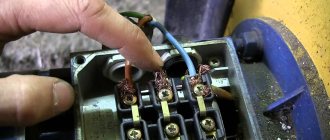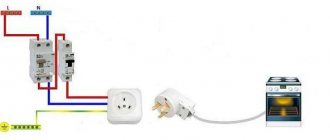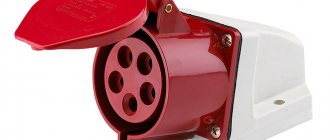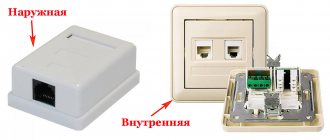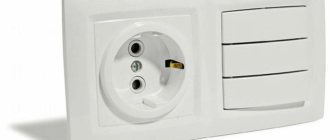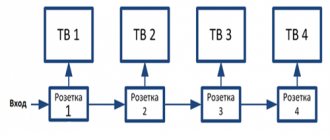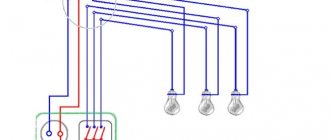Three-phase sockets and plugs are found mainly in houses with electric stoves of Soviet construction in the second half of the twentieth century. But when it comes to professional equipment, power electric motors or heaters, machines and equipment that use three phases in their work, there are many types of devices used to connect them. In everyday life, the average person rarely faces the need to receive a voltage of 380 volts from the network, which is formed as a result of a sinusoid shift by one third in each of the three phases of 220 volts, resulting in the indicated value. In fact, the specified voltage is supplied to each apartment building and residential area. So, no matter where the consumer is, if there is electricity there, then there is a high probability that there are three phases and the ability to connect to 380 volt networks.
Features of the 380V outlet
Takel Power Socket Fixed Internal 380 Volt
Power cable connectors are designed for harsh technical conditions. The industrial plug and heavy-duty 380V socket are protected by a durable housing that can withstand minor impacts. Simplicity of connection, strong plastic and high throughput allow the connection structure to be used outdoors, in industrial workshops or during construction work. The product is subject to increased safety requirements.
The contacts have a large contact area, which reduces the load and eliminates possible overheating. Each cable clamp is secured with a screw connection that holds the wire in its seat. The copper construction is protected from corrosion and is also resistant to oxide film growth.
The clamp holds the cable securely, preventing breakage. Special grooves ensure a strong connection and eliminate backlash. The contacts have different diameters and are located at their own angles. The connection provides protection against unbalanced connection, which prevents short circuits.
With high voltage, the risk of arcing increases. Each 380 socket has mechanical or automatic protection. The device can stop power supply until removed. The solution reduces the risk of equipment failure or skin burns.
The plastic is resistant to overheating, non-flammable and can withstand direct sunlight. Protection from dust and moisture is provided, which will preserve the quality of parts and make work safe.
The 380 volt electrical outlet is manufactured in accordance with the IP 44 or IP67 standard.
Types of sockets
Power connections differ in shape, method of fastening and number of contacts. The socket can have from 3 to 5 connections. To understand the difference, it is important to study the operating principle. In the CIS countries, a three-phase network with a voltage of 380V is used. A standard apartment uses 220V. This indicator can be obtained by connecting one of the three phases to the neutral wire. To connect a 380-volt industrial outlet, it is enough to combine two phases and a neutral wire. A conventional electric stove has a similar connection principle.
There are several standards for power connectors:
- 2P+PE - two phases and one grounded contact are used;
- 3P+PE - 3 power cables and one grounded;
- 3P+PE+N - 3 phases, one ground and zero;
- 3P+N - three power contacts and one neutral.
Socket 380V 2P+PE Socket 380 3P+PE
Socket 3P+PE+N
Plug 380 3P+N
Switching connections differ not only in the number of contacts, but also in the structure of the housing. There are cable structures that serve to connect portable devices. Flange switches are manufactured with a mount that can be built into the wall directly or at an angle. The last type is overhead sockets. Some cases are equipped with an additional protective cap.
Marking
The letter P indicates the power or phase wire, N stands for neutral, and the designation PE indicates the grounding cable. The wires are also color coded. Electrical installation rules require that the phase be designated in burgundy, red or brown, and zero in blue or a light blue tint. The earth is painted in two colors - yellow and green.
In addition to the voltage, the maximum permissible current is indicated on the case. An industrial 380V socket can withstand 16A, which is acceptable for a regular network. For more powerful ones, connections of 32, 63 and 125 amperes are used. To avoid overheating and fire, it is important to check the electrical current strength in advance.
The marking may also indicate the degree of protection. IP44 indicates that the outlet insulates electrically conductive areas from splashing water and dust particles. Often such cases are equipped with overhead protection.
The IP64 marking implies a completely sealed housing. Maximum protection allows connections to be made indoors or in open spaces with high humidity.
How to replace an old electrical plug?
If you have a regular Soviet electrical plug that needs to be replaced and at the same time the house has electrical wiring without grounding, the replacement method will be slightly different, namely:
- To begin, cut off the failed electrical plug and disassemble the body of the working product.
- As in the previous instructions, remove the outer sheath of the wire, strip the ends by 15-20 mm and bite off the excess.
- Since the design of a regular plug is slightly different - in particular the way the wires are attached, make rings from the stripped ends, as shown in the photo below:
- Connect the 2 wires to the electrical plug, not paying attention to the polarity. Please note that if you have 3 wires in the cord, the yellow-green one needs to be cut off, because there will be nowhere to connect it.
- After this, clamp the plate and assemble the body.
You can clearly see how to replace the plug yourself in the video instructions:
This is how you can replace the electrical plug yourself. As you can see, the most important nuance is to connect the wires correctly if there are 3 of them. To do this, you need to know the standard color marking of wires so as not to confuse anything. We hope that now you know how to change the plug on the wire with your own hands!
Connection methods
Power cable VVGng(A)-LS
High voltage is dangerous to life, so you should not neglect TB and connection rules.
The basis of any connection is the cable. It is important to choose the correct section that is suitable in size and can withstand the potential load. According to GOST, for a socket with a voltage of 380V and a current of 16 A, a wire with a cross-section of 1.5 to 4 mm is sufficient. The plug cable must be a minimum of 1.5 and no more than 2.5 mm. The thickness of the grounding wire should be 6 mm.
When installing switching elements, it is important to use the rule: supply cable - socket, receiving cable - plug. When stripping the wire, do not allow the wire to break off or become tangled. The more uniform the contact part of the cable is, the better the transmission and the less overheating.
Four-wire networks
Installation of wires begins with disassembling the housing. The 380 volt switch socket has 4 contacts, three of which are phase. Near the contacts you need to find the designations L1 L2 L3 and connect three phase wires to them in random order. Next, you need to find the neutral wire and clamp it to the terminal marked with the letter N.
Five-wire networks
When connecting a connector with five contacts, a scheme similar to the previous one is used. The designation near the contact pads is the same: L1 L2 L3 - phase, N - zero and PE - ground wire. The presence of earth requires an additional circuit element - an RCD. This connection will prevent electric shock if the housing or mounting rail is energized.
Connecting a three-phase socket
The connection can occur either with or without the use of an RCD. It all depends on the presence of a protective grounding cable. The connection is symmetrical, so the order of connecting the power cables is arbitrary. At the end of installation work, you should check the correct connection and correct errors.
What to look for when purchasing
If you need to choose a three-phase outlet, you should pay attention to the following points:
- The current strength for which it is designed. Most often you have to choose between 16, 32 or 64 amp models, depending on the device to which they will be connected.
- Level of protection against moisture and dust. To check, you need to look for the “IP” marking in the characteristics - the higher the number, the more reliable the protection. In practice, you need to pay attention to this only if the outlet is installed in a place with very high humidity.
- Do you need a stationary socket or a mobile one? To put it simply, they will hang it on the wall or make a carrier out of it.
- Number of contacts - selected depending on the use of a specific connection scheme.
- If you purchase sockets with self-clamping screwless contacts, then you need to make sure that they are working properly - so that they are not disposable.
Design tricks, shape and relative position of contacts - all these details depend on the specific manufacturer and may differ slightly in different device models. They only affect the convenience of finding a new outlet if it needs to be replaced.
Checking sockets
Before operation, it is important to do a check, which consists of four main points:
- Visual inspection for possible physical defects in the housing.
- If you have a megohmmeter, the strength of the insulating coating is checked. During diagnostics, the 380 volt outlet must be de-energized.
- A short circuit is created using the device to check the correct connection.
- Measurement of linear and phase voltage at idle.
During testing, the operating voltage between phases should be no more than 380V and 220V on one core. At the end, you should once again check the correctness and quality of the connection. A poorly tightened contact will overheat and fail, damaging the housing.
If the circuit opens, an arc may occur, creating a danger to life and risk of failure. To avoid this phenomenon, always turn off the power supply before dismantling. More expensive versions have an automatic transmission.
During operation, the wires heat up and expand. As a result, the screw connections become loose, resulting in poor contact. All wires must be re-tightened every year.
How does an electrical plug work?
Over the course of a long time, different countries have created their own standards for plug connectors. The purchase of foreign electrical equipment created difficulties in connecting it to domestic outlets.
In addition, new models of plugs and sockets were developed, which added even more confusion. Today in stores you can buy both old Soviet plug connectors and new imported ones.
Therefore, this article will discuss instructions for replacing electrical plugs of different standards.
Considering the main parts of the plug will help you understand how to properly change the plug on the wire. Any fork consists of the following parts:
The main task of the housing is to protect a person from electric shock. In addition, the contacts and wire are securely fastened in the housing. The housing can be of various shapes and sizes, collapsible or not.
The socket and plug must match each other not only in size, but also from a safety point of view. For example, a plug with partially insulated contacts can be used with outlets that have a flat surface.
Plugs with non-insulated contacts, to protect people from accidental contact with live parts, must be used with sockets that have a recess.
According to safety regulations, electrical appliances with a single-pole switch must be connected to polarized outlets.
In this case, both the plug and the socket each have three contacts arranged in the shape of a triangle; the plug can only be inserted into the socket with one side.
In this case, the wires are connected to the socket in such a way that the phase goes to the switch.
The contacts on plugs are usually made round, but there are models in which they are flat.
Round contacts come in diameters of 4 and 4.8 or even 7.05 mm, although in Russia this is very rare. In the Soviet Union there were contacts with slots, this gave them the properties of a spring, and they fit tightly into the socket sockets.
Modern plugs can also have spring contacts, but this is achieved not by cutting, but by bringing the pins together. Such plugs are cast; when pouring the pins, they are installed not parallel to each other, but with a slight toe-in.
The role of the spring is performed by the plastic of the fork. Such models can be used in sockets where there are no spring contacts.
Connecting an electrical plug to the wires can only be done on collapsible models. The methods for connecting the wires may vary, but as a rule, this is a threaded connection directly to the contact itself.
Recently, plugs with a grounding contact have been increasingly used; it can be made in the form of a pin or socket. In the latter case, the socket has a pin that fits into the plug socket.
Additionally, grounding plates are mounted on the sides of the case, which are slightly recessed into the case.
What kind of lighting do you prefer?
Built-in Chandelier
| When assembling the plug, ALWAYS secure the wire with a clamp. Otherwise, when you pull the plug out of the socket, all the force will be applied to the wires connected to the pins. This will lead to worsening contact in the future. |
Expert opinion
Viktor Pavlovich Strebizh, lighting and electrical expert
Any questions ask me, I will help!
To make sure that the 380-volt socket is connected accurately, it is recommended to use a multimeter turned on in the AC voltage measurement mode and use the diagram. If there is something you don’t understand, write to me!

